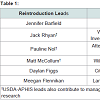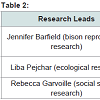Journal of Veterinary Science & Medicine
Download PDF
Editorial
*Address for Correspondence: Mark A. Brown, Department of Clinical Sciences, Colorado State University, 801 Oval Drive, Campus Code 1052, Fort Collins, CO 80523- 1052, USA, Tel: (970) 491-5782, E-mail: M.Brown@colostate.edu
Citation: Wilkins K, Brown MA. Assisted Reproductive Technologies Facilitate Reintroduction of Brucella abortus-Free, Genetically Pure Lineage of Bisonbison to Northern Colorado. J Veter Sci Med. 2015;3(2): 2.
Copyright © 2015 Wilkins K, et al. This is an open access article distributed under the Creative Commons Attribution License, which permits unrestricted use, distribution, and reproduction in any medium, provided the original work is properly cited.
Journal of Veterinary Science & Medicine | ISSN: 2325-4645 | Volume: 3, Issue: 2
Submission: 16 August 2015 | Accepted: 19 August 2015 | Published: 22 August 2015
Assisted Reproductive Technologies Facilitate Reintroduction of Brucella abortus-Free, Genetically Pure Lineage of Bison bison to Northern Colorado
Katherine Wilkins 1 and Mark A. Brown2-5*
- 1Graduate Degree Program in Ecology, Colorado State University, Fort Collins, USA
- 2Department of Clinical Sciences, Colorado State University, Fort Collins, USA
- 3Cell and Molecular Biology Program, Colorado State University, Fort Collins, USA
- 4Department of Ethnic Studies, Colorado State University, Fort Collins, USA
- 5Epidemiology Section, Colorado School of Public Health, USA
*Address for Correspondence: Mark A. Brown, Department of Clinical Sciences, Colorado State University, 801 Oval Drive, Campus Code 1052, Fort Collins, CO 80523- 1052, USA, Tel: (970) 491-5782, E-mail: M.Brown@colostate.edu
Citation: Wilkins K, Brown MA. Assisted Reproductive Technologies Facilitate Reintroduction of Brucella abortus-Free, Genetically Pure Lineage of Bisonbison to Northern Colorado. J Veter Sci Med. 2015;3(2): 2.
Copyright © 2015 Wilkins K, et al. This is an open access article distributed under the Creative Commons Attribution License, which permits unrestricted use, distribution, and reproduction in any medium, provided the original work is properly cited.
Journal of Veterinary Science & Medicine | ISSN: 2325-4645 | Volume: 3, Issue: 2
Submission: 16 August 2015 | Accepted: 19 August 2015 | Published: 22 August 2015
Abstract
Researchers at Colorado State University have partnered with the United States Department of Agriculture to reintroduce Bison bison to northern Colorado for the first time since the 19th century. Assisted reproductive technologies have been employed to ensure that the bison are of genetically pure lineage and brucellosis-free. The herd is set to be released onto Red Mountain Open Space, owned by Larimer County, and Soapstone Prairie, owned by the city of Fort Collins, in November 2015. Research will also be conducted on the ecological and social impacts of the reintroduction.Discussion
The North American bison (Bison bison), which once numbered in the millions, were diminished to a point of near-extinction by the latter half of the 19th century [1]. A subspecies, found in the United States, known as plains bison (Bison bison bison), has survived primarily as a reduced herd located in Yellowstone National Park. It is estimated that the current American bison population was derived from fewer than 100 animals [1]. The population of bison in the United States has since grown to over half a million, including the Yellowstone herd which is the largest group of bison which are known to be free of hybridization with domestic cattle.Using assisted reproductive technologies, researchers at Colorado State University (CSU) are building a herd of genetically pure plains bison by drawing upon the genetic lineage of the Yellowstone herd. These technologies ensure, that newly developed herds of bison are free of Brucella abortus which is known to infect some existing bison populations. For years, the reintroduction of pure bison has been slowed by fears that the animals will bring brucellosis to their new environments. Thus, the development of a brucellosis-free herd has vaulted conservationists over what was a daunting obstacle related to concerns over public health.
In addition to longitudinal studies related to the health of the new herd, CSU researchers will monitor ecological impacts, and collaborate with Denver Zoo researchers to evaluate the social effects of the bison reintroduction. For example, to assess impacts on bird, mammal, and vegetation communities, researchers are employing methods and tools such as point counts, wildlife cameras, vegetation transects, and grazing enclosures within fenced bison reintroduction sites, versus adjacent cattle-grazed and non-grazed sites. Likewise, structured visitor intercept interviews and surveys are being used to measure visitor experiences and place attachment. Collectively, this information will be used to inform future reintroduction initiatives. Over time, it is expected that data and experience gathered from the reintroduction of plains bison in northern Colorado will facilitate similar efforts in other locations throughout the United States, thereby ensuring the long term sustainability of genetically pure, brucellosis-free North American bison.
Key partners associated with the reintroduction are listed in Table 1. Project leads for the project research are listed in Table 2. A special commentary by project partners, with an update on the reintroduction efforts, will be highlighted in a forthcoming issue.



